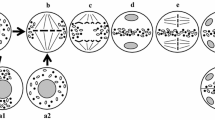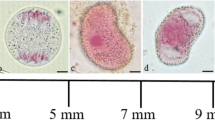Abstract
The underlying mechanisms responsible for elimination of three of the four meiotic products during microsporogenesis in sedges have remained obscure. Although programmed cell death (PCD) is known to be an integral part of plant development, several aspects, such as the enormous size difference between functional and eliminated cells, nuclear viability of the smaller cells targetted for elimination and the possible dangers of employing PCD-like mechanisms during gametophyte development point to a novel way of selective cell elimination associated with asymmetric division. This paper throws some light on the possible roles of cell plate dynamics and cell fate determinants in pseudomonad development. The rarity and significance of asymmetric division with morphogenetic consequences associated with meiosis are discussed in the context of generally prevalent, mitosis- associated asymmetric divisions during development.
Similar content being viewed by others
Author information
Authors and Affiliations
Additional information
Received: 16 December 1999 / Revision accepted: 28 March 2000
Rights and permissions
About this article
Cite this article
Ranganath, R., Rao Nagashree, N. Selective cell elimination during microsporogenesis in sedges. Sex Plant Reprod 13, 53–60 (2000). https://doi.org/10.1007/PL00009842
Issue Date:
DOI: https://doi.org/10.1007/PL00009842




